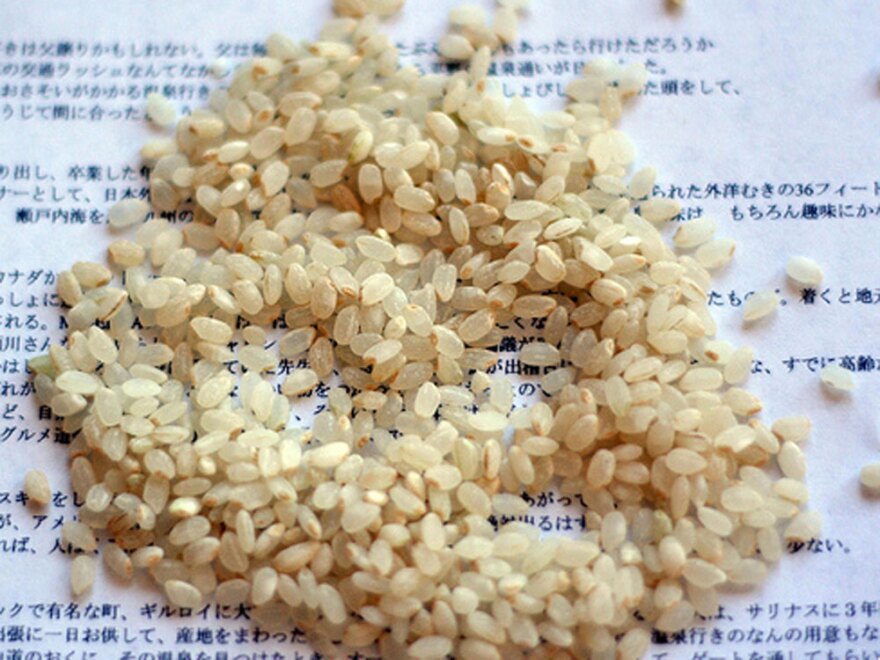"Planting rice is never fun. Bent from morn till set of sun" — I can still picture my 8-year-old self bending in unison with 30 classmates in a sea of blue pinafores as we planted "rice shoots" in the "mud" and sang the stilted lyrics to this folk song.
It must have been a strange sight to behold — a gaggle of schoolgirls mimicking rice planters in a paddy field during music class in Singapore. Yet it illustrates how deeply ingrained rice is in my Southeast Asian culture. Rice is an indispensable part of my diet like it is for many Asian immigrants.
As a little girl, cooking rice was one of the few kitchen chores I welcomed, probably because it was easy. I'd scoop four cups of rice into a steel rice bowl — purists may balk, but when I was growing up, rice always came out of a rice cooker that was decorated with pink peonies — and place it in the sink. A couple of turns of the tap, and whoosh, a steady stream of cold water would rush into the bowl. When the water reached halfway up the bowl, my tiny fingers swished and sloshed the rice grains until the crystal-clear water graduated to cloudy white. Then I'd tilt the bowl over the sink to drain the water out, cupping my free hand along the container's edge to prevent rice from falling out. I repeated this three or four times — less if my mom wasn't watching — until the water ran clear.
The hot and fluffy rice took pride of place in the center of the dinner table, forming the blank canvas of my childhood palate. ... The next day, any leftover rice was transformed into fried rice or thick rice porridge for breakfast.
Then, following Mom's lead, I'd stick my index finger into the bowl, its tip barely touching the surface of the rice, and fill the bowl with water until it reached the first joint of my finger. Into the cooker the bowl went, and I'd snap the lid shut. In 20 minutes flat, I'd open it again to fragrant, perfectly steamed rice.
The hot and fluffy rice took pride of place in the center of the dinner table, forming the blank canvas of my childhood palate, to be embellished by a stir-fry of bok choy and garlic, and turmeric fried chicken or spicy beef curry. The next day, any leftover rice was transformed into fried rice or thick rice porridge for breakfast.
As much as I hate to admit it, I've turned into my mother — this rice-eating habit has followed me into adulthood. No matter how much protein or how many potatoes I consume, if rice doesn't pass between my lips, my poor tummy comes away from the table not really rumbling, just not quite satisfied.
I do have some rice-eating caveats. When days are pushing 80 degrees, or now that I'm experiencing the joys of impending motherhood that include morning sickness, I hardly want to be slaving in front of a hot stove.
So what's a gal to do when she'd rather be spending time at the spa than in the kitchen and her palate craves foods with a little chill to them? I considered this in the summer just past and found the answer was simple: rethink rice. And so began my quest for no-cook — or as close to it as one can possibly get — rice recipes.
I've been inspired by visits to farmers markets and my favorite cookbook authors, and by experimenting with creative riffs on Asian favorites. The results were spectacular: a mound of rice studded with assorted seasonal vegetables, like gems, seasoned with my vinaigrette du jour; no-cook "fried" rice using the same ingredients but in different guises — grated carrots, shredded Chinese cabbage and crumbled hard-cooked eggs tossed with rice.

Along the way, I encountered previously unknown rice varieties at Asian markets and specialty grocery stores. While slender ivory shards of jasmine rice were a staple in my childhood, my diligent research led me to discover haigamai, a Japanese partially milled rice that has all the bran removed yet retains the nutrient-laden rice germ. It's just as nutritious and fiber-rich as brown rice, but is easier to chew and very tasty, with only a slightly grainier taste than white rice.
I've grown to love the reddish-brown hue of Thai red rice, some grains with the bran rubbed off to reveal the white beneath. The needle-thin grains are pretty to look at and have a pleasing chewy, nutty flavor.
Then there's good-for-the planet organic rice. Lundberg Family Farms in California, for example, grows jasmine, sushi, basmati and wild (the rice-like seed of a wild grass) rices using sustainable growing practices to enrich soils and improve crops.
I've approached my rice adventures with curiosity and playfulness, and I'm proud to say my rice repertoire has expanded and matured. Yet during the cool Indian summer evenings we are now experiencing in Monterey, you'll find me, chopsticks in hand, alternating between clumps of jasmine rice fished out of a bowl cupped in my left palm, and bites of garlicky bok choy.
Copyright 2023 NPR. To see more, visit https://www.npr.org. 9(MDM3NjYwMjA5MDE1MjA1MzQ1NDk1N2ZmZQ004))

